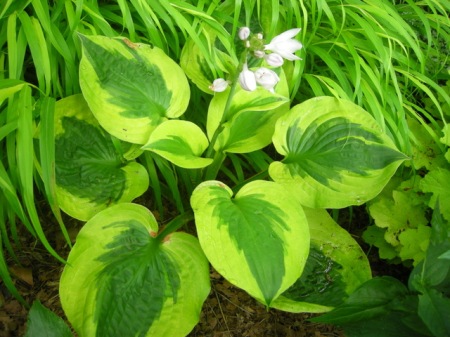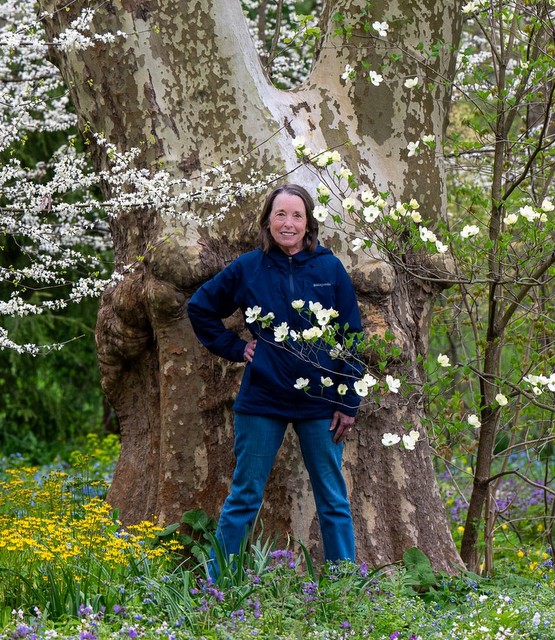Carolyn’s Shade Gardens is a retail nursery located in Bryn Mawr, PA, specializing in showy, colorful, and unusual plants for shade. The only plants that we ship are snowdrops and miniature hostas. For catalogues and announcements of events, please send your full name, location, and phone number (for back up use only) to carolyn@carolynsshadegardens.com. Click here to get to the home page of our website for catalogues and information about our nursery and to subscribe to our blog.
 Although miniature hostas are versatile, cute, and fun, it is the larger hostas that provide the bold statement and beautiful colors in shade gardens. Here clockwise from top: ‘Blue Angel’, ‘Flavocircinalis’, ‘Gold Bullion’, and ‘Striptease’.
Although miniature hostas are versatile, cute, and fun, it is the larger hostas that provide the bold statement and beautiful colors in shade gardens. Here clockwise from top: ‘Blue Angel’, ‘Flavocircinalis’, ‘Gold Bullion’, and ‘Striptease’.
.
I have explained in previous posts how my hosta addiction has progressed and focused on little hostas. However, that doesn’t mean that I neglect the larger hostas. I have my definite favorites there too. In fact, some of them are such favorites that, when I couldn’t buy them to sell to my customers, I decided to grow them myself just so they would be available for sale at Carolyn’s Shade Gardens. In this post, I am going to profile seven of those hostas, all of which I consider stars of the shade garden. Be sure to look at the mature specimens in my garden when you visit.
.
 ‘Rainforest Sunrise’ with ‘Frosted Violet’ coralbells
‘Rainforest Sunrise’ with ‘Frosted Violet’ coralbells
.
‘Rainforest Sunrise’ is the 2013 Hosta of the Year, a prestigious award bestowed yearly by the American Hosta Growers Association on only one of the 8,000 cultivars in existence. For beautiful photos of all the yearly winners, click here. It forms a small mound 10″ high and 25″ wide—very useful in smaller shade gardens and smaller spaces. Its cupped and corrugated bright gold leaves with a sharply contrasting dark green margin are 6″ long and 5″ wide and really stand out in the shade. ‘Rainforest Sunrise’ has lovely near white flowers in July.
.
 ‘Dream Queen’ with maidenhair fern and ‘All Gold’ Japanese forest grass (Hakonechloa).
‘Dream Queen’ with maidenhair fern and ‘All Gold’ Japanese forest grass (Hakonechloa).
.
‘Dream Queen’ is an offshoot of ‘Great Expectations’ with the same gorgeous leaves and habit but much bluer foliage. It forms an upright and spreading mound 24″ high and supposedly 50″ wide at maturity, although I have had mine for years and it is not that wide. The 12″ long by 10″ wide round leaves have a narrow yellow center stripe surrounded by deep blue. They are heavily corrugated and have thick, slug-deterring substance. ‘Dream Queen’ produces near white flowers from late June into early August.
.
 ‘Pineapple Upsidedown Cake’ with hellebores and Japanese holly fern
‘Pineapple Upsidedown Cake’ with hellebores and Japanese holly fern
.
‘Pineapple Upsidedown Cake’ makes a tremendous specimen in my garden with its unusual look and habit. It forms a fast-growing mound 18″ high and up to 50″ wide, although my mature specimen is about half that size. The narrow, rippled, bright gold leaves with dark green margins are 9″ long and 3″ wide. Unlike most hostas, they become more gold as the season progresses. It produces lavender flowers in August.
.
 ‘Orange Marmalade’ with ‘Blackout’ coralbells
‘Orange Marmalade’ with ‘Blackout’ coralbells
.
‘Orange Marmalade’ is a striking addition to my yellow and gold garden with its bright gold-orange centers throughout spring. It forms a mound 20″ high by 45″ wide at maturity. The prominent blue-green margin on the 7″ long by 5″ wide leaves sets off perfectly the orangey centers. It produces lavender flowers from mid-July into early August. ‘Orange Marmalade’ is an off-shoot of ‘Paul’s Glory’ with all the wonderful attributes of that 1999 hosta of the year but a brighter center color.
.
 ‘Tick Tock’ has a starring role in my little hosta rock garden.
‘Tick Tock’ has a starring role in my little hosta rock garden.
.
‘Tick Tock’ is another beautiful hosta suitable for smaller spaces. It forms an elegant symmetrical mound 10″ high by 18″ wide. Its thick 4″ by 2″ gold leaves are set off by wide blue-green margins. It produces lavender flowers in July. What ‘Tick Tock’ most resembles is a mini ‘June’ for smaller gardens.
.
 ‘Summer Lovin’ with clockwise from top: ‘All Gold’ Japanese forest grass, pulmonarias, native ‘Citronelle’ coralbells, hellebores, and native Indian pink (Spigelia).
‘Summer Lovin’ with clockwise from top: ‘All Gold’ Japanese forest grass, pulmonarias, native ‘Citronelle’ coralbells, hellebores, and native Indian pink (Spigelia).
.
.
‘Summer Lovin’ is the star of my yellow and gold garden, pulling together all the various hues and textures as you can see in the top photo. It forms a mound 18″ high and 40″ wide. What is so special about it is the way the unusually wide gold margins contrast with the dark green center—very unique. The leaves are 7″ long and 6″ wide and have thick, slug-resisting substance. It produces compact and attractive pale lavender flowers in July.
.
 ‘Flavocircinalis’ makes a wonderful specimen.
‘Flavocircinalis’ makes a wonderful specimen.
.
 ‘Flavocircinalis’ leaf close up
‘Flavocircinalis’ leaf close up
.
‘Flavocircinalis’, not exactly a user friendly name, means the well-rounded hosta and is a cultivar of my favorite hosta species Hosta tokudama. Although Mark Zilis, author of the definitive hosta reference book The Hostapedia, calls it “one of the greatest hosta cultivars ever introduced”, it is hard to find and expensive when you do find it. Wholesale growers don’t like it because it grows slowly in pots. I grew it myself this year so I could sell it to my customers at a reasonable price.
‘Flavocircinalis’ forms a mound 17″ high and 48″ wide at maturity. Its 9″ by 7″ blue-green leaves have a wide gold margin. They are heavily corrugated, wavy, and have thick substance. The attractive white flowers bloom from mid-June into early July.
.
Those are just some of the new larger hostas available at Carolyn’s Shade Gardens this year. If you would like to read more about the larger hostas available for sale, click on any of the following links:
Larger Hostas explains how large leaf hostas take a year to produce mature leaves, gives ideas for using them, and profiles ‘Flavocircinalis’, ‘Earth Angel’, ‘Great Expectations’, and ‘First Frost’.
Larger Hostas Get the Spotlight profiles ‘Blue Angel’, ‘Sagae’, and ‘Great Expectations’ with photos of how I have use them in my garden.
Hostas for Fall profiles hostas that hold up to the heat and slugs to look beautiful in fall, including ‘Stained Glass’, ‘Frances Williams’, ‘Blue Angel’, ‘Sum and Substance’, ‘Halcyon’, and ‘Praying Hands’, all available this year at Carolyn’s Shade Gardens.
Carolyn
.
Carolyn’s Shade Gardens is a retail nursery located in Bryn Mawr, Pennsylvania, U.S., zone 6b. The only plants that we mail order are snowdrops and miniature hostas and only within the US.
If you are within visiting distance and would like to receive catalogues and information about customer events, please send your full name and phone number to carolynsshadegardens@verizon.net. Subscribing to my blog does not sign you up to receive this information.
Nursery Happenings: The 2013 Miniature Hosta Mail Order Catalogue, containing over 35 choice selections of miniatures for shipping all over the US, is now on the right sidebar here, and we are ready to ship. If you are local, you can use the catalogue to see what miniatures are available at the nursery. Next up is the final open house sale of the season on Saturday, June 1, from 10 am to 3 pm rain or shine, and featuring summer- and fall-blooming shade plants. If you are a customer, expect an email shortly with all the details.
Facebook: Carolyn’s Shade Gardens has a Facebook Page where I post single photos, garden tips, and other information that doesn’t fit into a blog post. You can look at my Facebook page here or click the Like button on my right sidebar here.
Notes: Every word that appears in orange on my blog is a link that you can click for more information. If you want to return to my blog’s homepage to access the sidebar information (catalogues, previous articles, etc.) or to subscribe to my blog, just click here.































